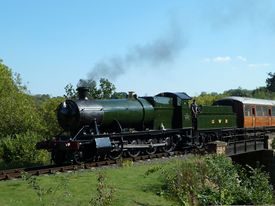GWR 2857 Heavy Goods Loco
2857 is a GWR Churchward 2800 Class locomotive, designed for heavy freight work and classified 8F by BR.
Contents
2857 in service
2857 was built in 1918 at the GWR’s Swindon Works and delivered new to Salisbury GWR depot. During a working life of 45 years it was based in many depots around the GWR (and later British Railways Western Region), including a brief spell at nearby Stourbridge shed. The locomotive was withdrawn from Neath depot in April 1963 having recorded a total of 1,276,713 miles in service. It is fitted to a 3500 gallon tender.
2857 in preservation
2857 was purchased from Woodham Bros scrapyard in 1974 by The 2857 Society, and moved by rail from Barry to the Severn Valley Railway in convoy with Collett Mogul 7325, arriving on 20th August 1975.
The locomotive was first steamed in preservation on 9th September 1979, minus cladding, and was steamed intermittently through 1980, without entering regularly in service. It finally entered service in August 1985, and worked until withdrawn for overhaul in December 1994 (1992 was spent on loan to the Gloucestershire Warwickshire Steam Railway).
As a heavy freight locomotive, 2857 was not suitable for main line passenger railtours, but made one appearance on the main line in 1985:
| Date | Tour name | Route | Notes | Web | SVR News |
|---|---|---|---|---|---|
| 10 Sep 1985 | GW 150 Freight Demo | Kidderminster-Hereford-Newport + return | 25 SVR wagons also used | 78-17 | |
| For further information on sources and references, see The Severn Valley Railway on the main line | |||||
Filming took place in October 2000 for an episode of the 2001 TV series “ Off the Rails” featuring Vince Henderson. The restoration of 2857 was one of the items featured, although the commentary referred to the locomotive as a pannier tank!
After overhaul, 2857 re-entered service in July 2011.
In 2014, 2857 recorded the highest annual mileage of any steam locomotive on the SVR that year, being the only steam loco to travel over 10,000 miles on the railway.[1]
Gallery
See Also
References
- ↑ Severn Valley Railway News 189 (Spring 2015), p21

